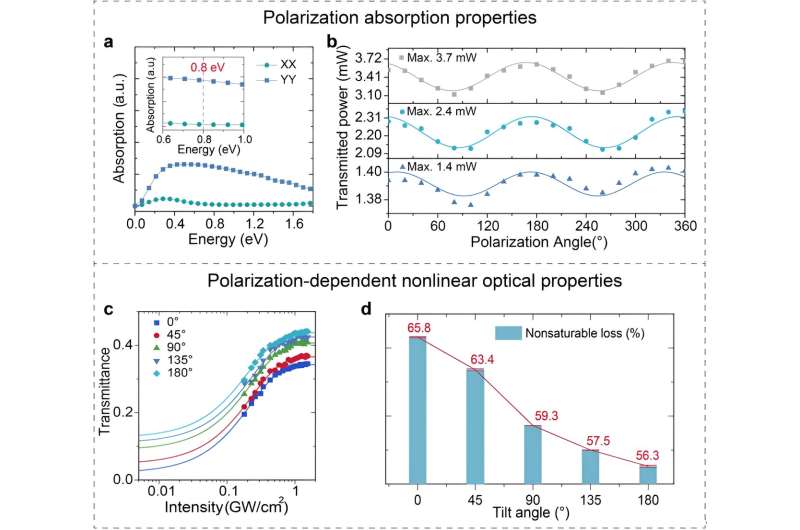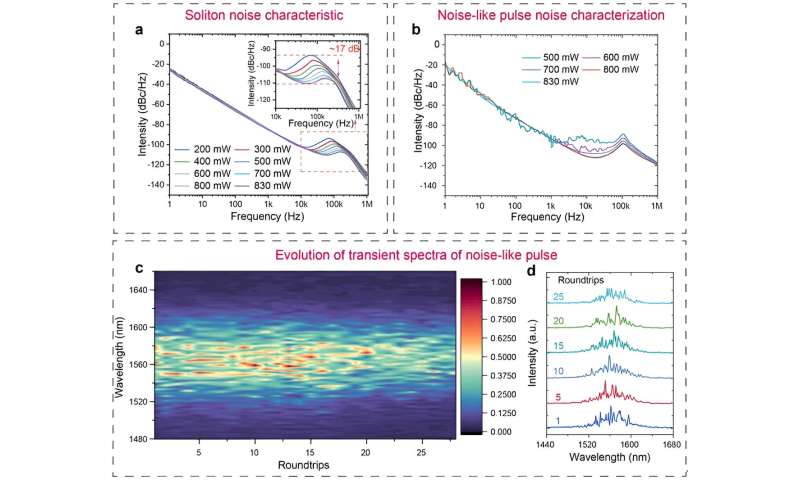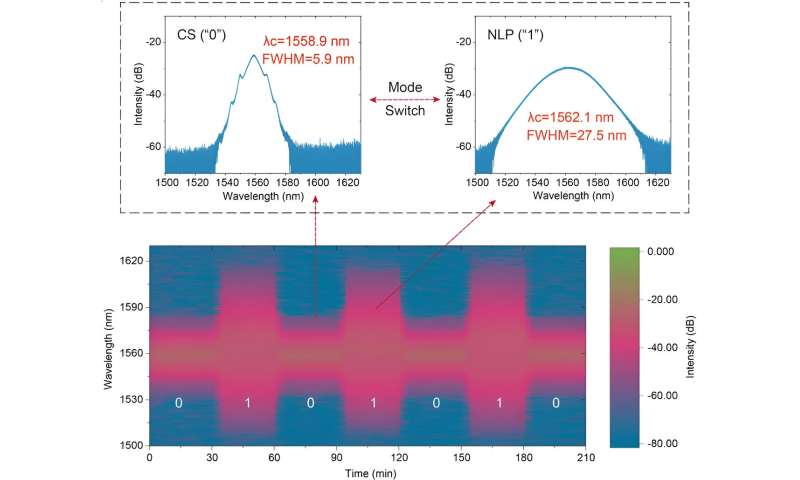This article has been reviewed according to Science X's editorial process and policies. Editors have highlighted the following attributes while ensuring the content's credibility:
fact-checked
peer-reviewed publication
proofread
Team reports on ultrafast laser state active controlling based on anisotropic quasi-1D material

Tunable ultrafast lasers with adjustable parameters, such as wavelength, intensity, pulse width and laser states are desirable as next-generation intelligent light sources. Due to complex nonlinear effects within the ultrafast system, it is challenging for laser state active controlling (LSAC) in ultrafast fiber lasers, especially for passive mode-locking, in a convenient and controllable manner.
Anisotropic low-dimensional materials with reduced in-plane symmetry exhibit polarization-dependent properties, providing additional degrees of freedom in compact tunable photonic devices.
In a new paper published in Light: Science & Applications, a team of scientists led by Professor Pu Zhou from the College of Advanced Interdisciplinary Studies, National University of Defense Technology, China, Professor Kai Zhang from Suzhou Institute of Nano-Tech and Nano-Bionics, Chinese Academy of Sciences, China, and co-workers has achieved the LSAC between conventional soliton (CS) and noise-like pulse (NLP) by polarization control based on a quasi-one-dimensional layered material switcher.
The polarization-sensitive nonlinear optical response facilitates the Ta2PdS6-based mode-lock laser to sustain two laser states, i.e., CS and NLP. The laser state was switchable in the single fiber laser with a mechanism revealed by numerical simulation. Digital coding was further demonstrated in this platform by employing the laser as a codable light source.
-

a, The phase noise characteristics of the CS state laser. b, The phase noise characteristics of the NLP state laser. The pulse noise performance of the two different states shows that the phase noise (timing jitter) of the CS state is better than the NLP. c, DFT recording of single-shot spectra over 25 consecutive round trips d, The six typical frames of NLP spectra based on the dispersive Fourier transform technique. The flanking of the NLP spectra measured by the dispersive Fourier transform technique varies from shot to shot, but the bandwidth remains essentially unchanged when compared with that of the spectrometer. Six typical frame-by-frame spectral traces illustrate the evolution of the NLP spectrum more visually. The strongest peaks of its spectrum alternate at the center wavelength, and the evolution of the sidebands is rather chaotic. The phenomenon can be attributed to the properties of NLP, i.e., a cluster of pulses consisting of a series of sub-pulses with randomly distributed amplitudes and durations. Credit: Zixin Yang, Qiang Yu, Jian Wu, Haiqin Deng, Yan Zhang, Wenchao Wang, Tianhao Xian, Luyi Huang, Junrong Zhang, Shuai Yuan, Jinyong Leng, Li Zhan, Zongfu Jiang, Junyong Wang, Kai Zhang, and Pu Zhou -

In the pump power range of 450mw ~ 830mw, switching between two different laser states, CS and NLP, can be achieved at a constant pump power by simply adjusting the tilt angle of the polarization controller. The output spectrum of a Ta2PdS6-based ultrafast fiber laser for a continuous conversion operation over a period of 3.5 h. The spectra of the two laser states before and after the conversion are unchanged, demonstrating the stability of the state switching of the ultrafast fiber laser based on Ta2PdS6. Credit: Zixin Yang, Qiang Yu, Jian Wu, Haiqin Deng, Yan Zhang, Wenchao Wang, Tianhao Xian, Luyi Huang, Junrong Zhang, Shuai Yuan, Jinyong Leng, Li Zhan, Zongfu Jiang, Junyong Wang, Kai Zhang, and Pu Zhou
Polarization control is a practical approach to adjusting the intracavity parameters and controlling the operating laser states.
Summarizing the main findings from the tunable ultrafast laser, the scientists say, "(1) the anisotropic quasi-one-dimensional layered material Ta2PdS6 was utilized as a saturable absorber to modulate the nonlinear parameters effectively in an ultrafast system by polarization-dependent absorption; (2) the polarization-sensitive nonlinear optical response facilitates the Ta2PdS6-based mode-lock laser to sustain two distinct types of laser states, i.e., CS and NLP; (3) the laser state was switchable in the single fiber laser with a mechanism revealed by numerical simulation; and (4) digital coding was further demonstrated in this platform by employing the laser as a codable light source."
"The controlled and stable switching of distinct pulsed laser modes in a single ultrafast fiber laser system represents significant advances in compact ultrafast photonics, which offers prospects of applications such as communications coding and optical switching."
More information: Zixin Yang et al, Ultrafast laser state active controlling based on anisotropic quasi-1D material, Light: Science & Applications (2024). DOI: 10.1038/s41377-024-01423-3
Journal information: Light: Science & Applications
Provided by Changchun Institute of Optics, Fine Mechanics And Physics



















